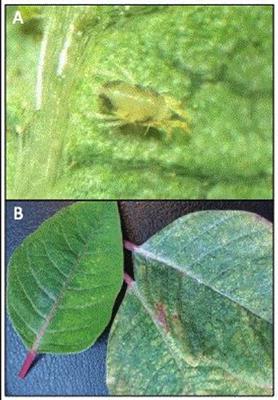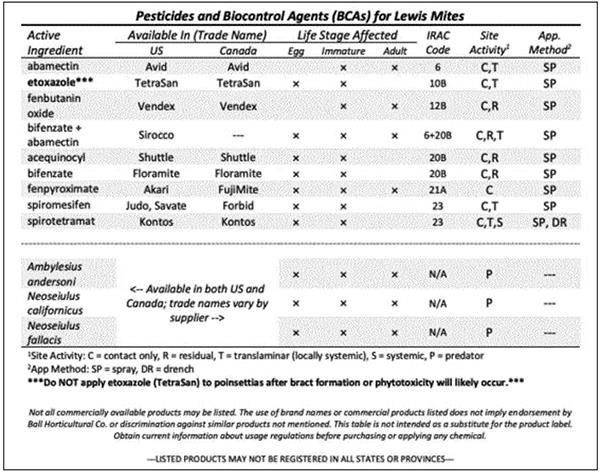Allow us to re-share the following tips and tricks for controlling Lewis mites on your poinsettia crop. Our technical services experts posted these in the Tech On Demand newsletter almost one year ago to the day. In other words, this pest seems to be back in 2025! Here's the scoop from Nick Flax.
PROBLEM: Lewis mites (Eotetranychus lewisi) might not be considered a major pest of floriculture crops, but they certainly appeared in North American greenhouses last fall during poinsettia production season. And like I explained last year, infestations early in the crop cycle can be managed with minimal impact to crop quality, but unmanaged populations can create significant challenges for you as crops approach finish.
NICK’S TIP: Scout your poinsettias thoroughly and ramp up control measures ASAP if signs of Lewis mites appear. I’ll share some identification tips, management protocols and control strategies in case you spot these pests again this fall.
Identification
Lewis mites are about 0.3 mm in length at mature size and range from green to yellowish in color as immatures but develop to a light orangish color as they mature.

Unlike two-spotted spider mites (TSSM; Tetranychus urticae), Lewis mites lack the (proportionally) large, dark-colored spots on their abdomens or other eye-catching identification traits.
Due to their size, magnification is necessary to scout for Lewis mites effectively. Use at least a 20x magnification hand lens when scouting suspicious plants.
Lewis mites tend to congregate along leaf veins or edges as populations grow. Eggs are laid on the undersides of leaves and start off clear in color but develop to a milky white color before they hatch.
Stippling damage caused by Lewis mites is often faint in the early stages of an outbreak and mimics mild chlorosis in poinsettias. NOTE: Since feeding is frequently concentrated along veins as populations grow, many growers mistake these symptoms for mineral nutrient deficiency symptoms.
Fig 1A & B. Lewis mites (Eotetranychus lewisi; top) are almost impossible to see with the naked eye. Under magnification, small dark-colored spots can be observed along the sides of their abdomens. Damage caused by Lewis mites (bottom) is often confused with mineral nutrient deficiencies. Minor damage to newer growth (bottom left) is easily dismissed or overlooked. Photo credit: (A) UCANR & (B) Judy Colley, Plant Products via ONfloriculture
Life Cycle
Lewis mites have one larval and two nymphal stages before they mature into adults. They can complete their life cycle in about 14 days at an average daily temperature of 77F (25C). In contrast, TSSM can complete their life cycle in as few as few as 3 days under optimal temps. Adult Lewis mites lay as many as 90 eggs per month, although much slower than TSSM, which can lay about 100 eggs in 10 days.
The comparatively slow life cycle of Lewis mites contributes to why populations often go undetected until crops are mature. Once populations reach a critical mass, webbing is visible, and damage is severe; affected plants may be unsalable.

Management Strategies
Due to the sporadic incidences of Lewis mite outbreaks, it’s not typical for growers to implement dedicated preventative measures for them. Those of you who utilize conventional insecticide-based IPM strategies should lean on early scouting and detection efforts to prevent major damage or losses. Implement an appropriate miticide spray rotation ASAP when a Lewis mite infestation is confirmed.
If your IPM strategy focuses on the use of biological control agents (BCAs) and conventional miticide sprays are necessary to curb an outbreak, consult your BCA supplier(s) to develop measures that knock down Lewis mite pressure effectively while minimizing negative impacts to BCAs that manage other target pests in your operation.
Control Measures
Before you apply anything to control Lewis mites, always read the label and follow all instructions regarding the number of times a given active ingredient may be applied to a single crop. Also be sure to:
• Use controls that target multiple life stages.
• Rotate IRAC groups between every miticide application.
• Use a combination of systemic, translaminar and contact miticides to ensure full coverage.